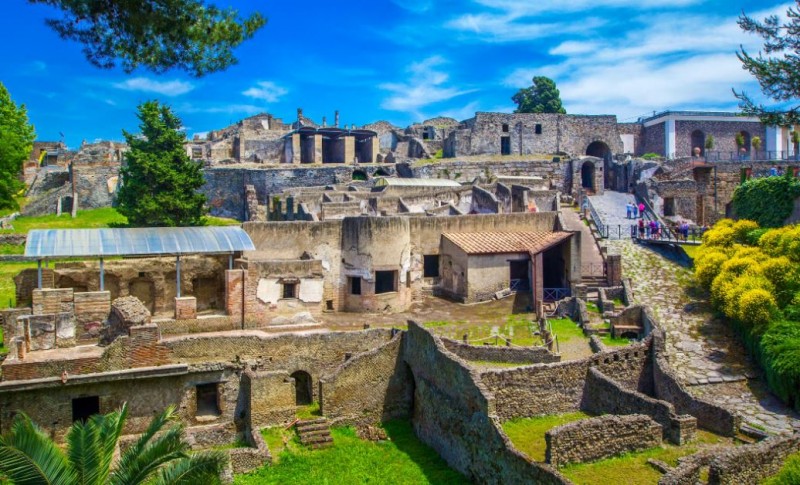
The ancient city of Pompeii, nestled near the Bay of Naples in Italy, stands as a remarkable testament to the power of nature and the enduring legacy of the Roman Empire. Frozen in time by the catastrophic eruption of Mount Vesuvius in 79 AD, Pompeii offers a unique glimpse into the daily life, culture, and architecture of the Roman civilization. This article explores the fascinating story of Pompeii's preservation and the invaluable insights it provides into the Roman way of life.
1. Introduction: The Ancient City of Pompeii
Nestled in the region of Campania, Italy, Pompeii was a thriving Roman city that existed during the first century AD. It was a bustling hub of trade, culture, and urban life. However, the city's fate took an unexpected turn when Mount Vesuvius, a nearby volcano, erupted with unimaginable force.
2. The Eruption of Mount Vesuvius
In the year 79 AD, Mount Vesuvius unleashed one of the most catastrophic volcanic eruptions in recorded history. The explosion sent a massive column of ash, rocks, and gases high into the sky. Within hours, the city of Pompeii was engulfed in a thick layer of volcanic ash, effectively freezing it in time.
3. Buried in Ash: Preservation of Pompeii
The volcanic ash that blanketed Pompeii acted as a natural preservative, creating a time capsule that preserved the city for nearly two millennia. The ash covered the buildings, streets, and even the inhabitants of the city, capturing the intricate details of daily life and the devastating effects of the eruption.
4. Rediscovery and Excavation
Pompeii lay buried and forgotten for centuries until its rediscovery in the 18th century. Excavations began, slowly unveiling the ancient city and revealing its well-preserved structures, artifacts, and human remains. These findings sparked a renewed interest in Pompeii and shed light on the advanced urban planning and architecture of the Roman Empire.
5. Urban Planning and Architecture in Pompeii
Pompeii offers a remarkable example of Roman urban planning and architecture. The city was meticulously designed, with wide streets, a complex water system, and an organized grid pattern. Magnificent structures, such as the Forum, amphitheater, and luxurious villas, provide insights into the city's social, political, and economic life.
6. Daily Life in Pompeii
Through the preserved remains and artifacts, historians have gained invaluable knowledge about the daily life of Pompeii's inhabitants. The excavations have uncovered houses, shops, and public buildings that reflect the Roman lifestyle. Wall paintings, mosaics, and household items offer glimpses into the daily routines, fashion, and customs of the ancient Romans.
7. The Social Hierarchy of Pompeii
Pompeii's social structure was diverse and hierarchical. The city was home to a range of social classes, including wealthy patricians, merchants, freed slaves, and laborers. The excavations have revealed stark differences in housing, possessions, and burial practices, highlighting the social disparities of the time.
8. Economy and Trade
As a bustling commercial center, Pompeii played a vital role in the Roman economy. The city thrived on trade, with its strategic location facilitating the movement of goods and resources. Excavations have unearthed marketplaces, warehouses, and evidence of trade networks, offering insights into the economic activities and prosperity of the city.
9. Religion and Worship
Religion held a significant place in Pompeii's society. The city was home to numerous temples, shrines, and cults dedicated to various gods and goddesses. Archaeological findings have revealed altars, statues, and frescoes that depict religious rituals and practices, providing a deeper understanding of the religious beliefs and spirituality of the ancient Romans.
10. Art and Culture in Pompeii
Pompeii was a hub of artistic and cultural expression. The city's buildings and public spaces were adorned with elaborate frescoes, intricate mosaics, and sculptures, showcasing the artistic prowess of the time. The art of Pompeii reflects the influence of both Roman and Greek styles, emphasizing the cosmopolitan nature of the city.
11. Pompeii and Roman Entertainment
Entertainment held a vital role in the lives of Pompeii's inhabitants. The city boasted a grand amphitheater, where gladiatorial contests and theatrical performances were held. The excavations have also revealed numerous brothels, suggesting a flourishing sex industry in Pompeii.
12. Legacy and Historical Significance
The preservation of Pompeii has provided invaluable insights into the daily life, culture, and architecture of the Roman Empire. The city stands as a testament to the destructive power of nature and the resilience of human civilization. Today, Pompeii is a UNESCO World Heritage Site and a popular tourist destination, attracting millions of visitors each year.
Conclusion
The ancient city of Pompeii, frozen in time by the volcanic eruption of Mount Vesuvius, offers a remarkable window into Roman life. The meticulous preservation of the city has allowed historians to unravel the mysteries of the past, revealing the social, cultural, and economic fabric of the Roman Empire. Pompeii's legacy continues to captivate and educate visitors from around the world, providing a tangible connection to the ancient world.
10 Must-Visit Places in Europe for an Unforgettable Journey